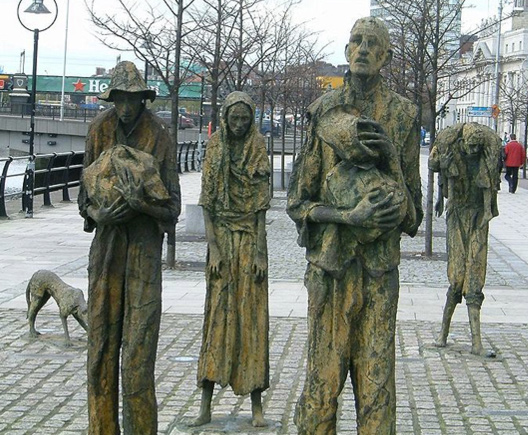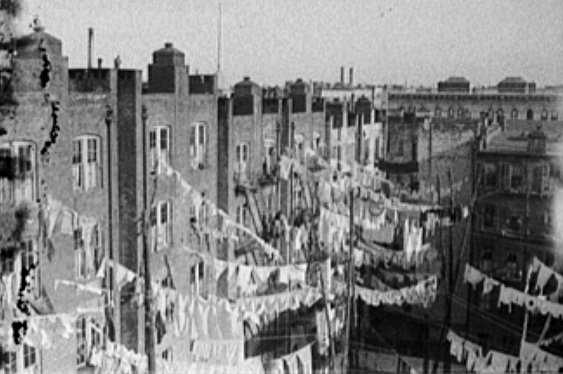
Source: Famine memorial Dublin, Wikipedia
Between the years 1820 and 1860 it is estimated that 3-4 million Irish migrated to the United States. Ireland was under British control. British landlords were harsh and oppressive to their Irish tenant farmers. In addition to this treatment, The Great Potato Famine (1845-1849) began when a fungus began to attack and kill the crops (mostly potatoes) of the Irish peasant farmers. The crops were literally rotting in the ground.
This photo shows an abandoned farm in Ireland. Roll your mouse over the photo to find more information.
Source: Abandoned farm in Ireland, Geograph Ireland
Image of a rocky hillside. A crumbled rock building lies at the base of the hill.With few crops to harvest and sell, many families had barely enough food for themselves and could not make any money. British landlords were unsympathetic and demanded rent anyway. Some families sold possessions to try and keep their homes. As more and more people became poverty stricken mass starvation, or famine, began. Undernourished people had weak immune systems and fell ill. Many Irish peasants had little hope of even surviving in Ireland's deteriorating conditions.
Irish families began to leave on ships for America. Many had no money to pay the ticket and became indentured servants, meaning once they arrived in America they had to work for a specific time period for the person who paid the ticket price.
This photo shows memorial sculptures in Dublin, Ireland. They are dedicated to those Irish peasants who suffered under extreme poverty and famine during the mid-1800s.

Source: Famine memorial Dublin, Wikipedia
The Irish encountered discrimination by many Americans upon their arrival. They were very poor, and would work for very low wages. Americans began to resent this because the Irish presence brought the hourly and daily wages down in many areas. Cities, like New York City, saw Irish immigrants clustered in dilapidated tenement housing. Due to their poverty they became known as dirty and sick. Some factories began to replace their workers with Irish workers to save money, because they would work for so much less money.

Source: New York, NYC yard of tenement, Wikimedia
This is a New York City tenement. The apartments were small, badly ventilated, without toilet or water.
Often 2 or 3 families would have to share an apartment. Children went to work with parents or fended for themselves. There were no public schools or daycares.
The Irish, being discriminated against, tended to live in their own ethnic communities. Politicians began to see the potential in winning over the Irish vote as the number of Irish immigrants increased rapidly. As the Irish learned the power of the vote, they began to use that power to demand opportunity, better wages, and eventually education from the politicians seeking out their votes. The Irish began to run for political offices and their communities did begin to see improvements. Many historians give credit to the Irish for the American public school system.

Take another look at the sculpture that depicts the impact of the Irish who migrated as a result of The Great Potato Famine. Imagine that you are a biographer; your assignment is to choose one of the figures and tell his or her story. Explain why this person migrated to America. Write the story in your notes.